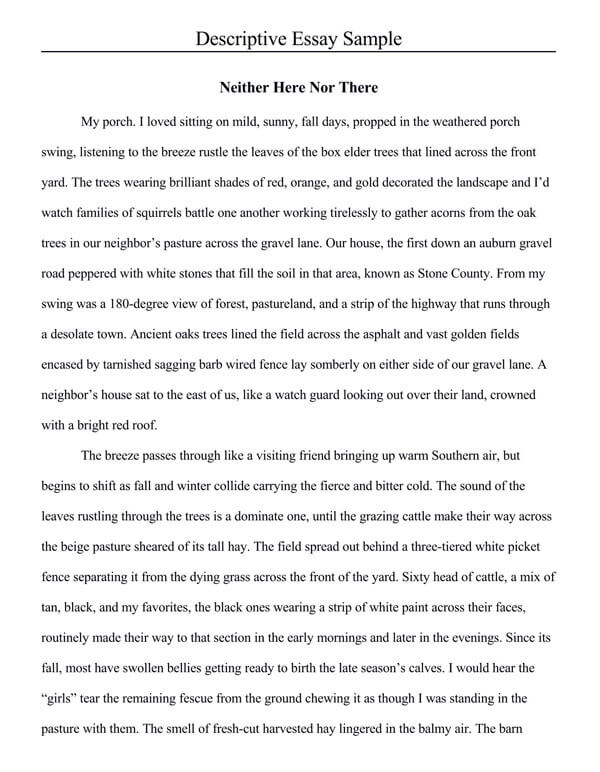Descriptive essays are a unique form of writing that allows you to create vibrant and immersive experiences through words. Whether you’re a student aiming to improve your writing skills or an aspiring author seeking to evoke emotions in your readers, mastering the art of descriptive essays is essential. In this comprehensive guide, we will explore everything you need to know about writing descriptive essays, including examples with excerpts, a variety of descriptive essay topics, the structure, tips for enhancing your descriptive writing, and the critical do’s and don’ts in this captivating genre.

Table of Contents
How to Write a Descriptive Essay
a. Select a Compelling Topic:
Begin by choosing a subject that genuinely interests you or holds personal significance. Your passion for the topic will shine through in your writing.
b. Brainstorm Ideas:
Before you start writing, take some time to brainstorm ideas and jot down notes or keywords related to your chosen subject. This will help you organize your thoughts and create a structured outline.
c. Create an Outline:
Structure your essay with a clear beginning, middle, and end. Consider the order in which you’ll present your ideas or descriptions to ensure a logical flow.
d. Start with a Strong Introduction:
As mentioned earlier, the introduction should capture the reader’s attention with a hook, provide context, and present a clear thesis statement that outlines the main impression or emotion you intend to convey.
e. Develop Detailed Body Paragraphs:
Each body paragraph should focus on a specific aspect or detail of the subject. Use sensory details, vivid language, and examples to paint a comprehensive picture.
f. Transition Smoothly:
Ensure that your paragraphs transition smoothly from one to the next. Use transitional words and phrases to guide the reader through your essay.
g. Use Dialogues and Anecdotes:
Incorporate dialogues and anecdotes if relevant to your subject. These can add depth and authenticity to your descriptions.
h. Revise and Edit:
After completing your initial draft, take the time to revise and edit your essay. Pay attention to sentence structure, grammar, spelling, and overall coherence.
i. Seek Feedback:
Consider sharing your essay with others, such as peers, teachers, or writing mentors, to gain valuable feedback and perspectives.
j. Polish Your Conclusion:
In your conclusion, summarize the key points and restate the main impression or emotion you aimed to convey. Leave the reader with a lasting image or thought.
k. Final Proofreading:
Before submitting your essay, perform a final proofread to catch any remaining errors or areas for improvement.
The Structure of a Descriptive Essay
A well-structured essay is essential to maintain a coherent and engaging narrative flow. Consider organizing your descriptive essay using the following framework:
a. Introduction:
Hook to grab the reader’s attention.
A brief overview of the subject.
Clear thesis statement outlining the intended impression.
b. Body Paragraphs:
Typically, three to five paragraphs, each focusing on a distinct aspect or detail of the subject.
Begin each paragraph with a topic sentence that provides a clear direction.
Incorporate sensory details to create a vivid description.
c. Conclusion:
Summarize the key points presented in the body paragraphs.
Reiterate the overall impression you aimed to convey.
Leave the reader with a lasting image or emotion.
Understanding Descriptive essay
Using Vivid and Evocative Language
Descriptive essays thrive on descriptive language. Utilize adjectives, adverbs, and strong verbs to weave a rich tapestry of imagery. Employ metaphors, similes, and personification to add depth to your descriptions. Avoid vague or generic terms, opting instead for precise and unique vocabulary.
Example Excerpt: “The setting sun cast a warm, golden hue over the tranquil lake, turning the water’s surface into a liquid mirror that gently reflected the silhouettes of the surrounding trees.”
Engaging the Senses
The hallmark of a great descriptive essay is its ability to engage the reader’s senses. Describe how the subject appears, sounds, smells, tastes, and feels. This multisensory approach immerses your readers in your narrative, creating a more profound and memorable reading experience.
Example Excerpt: “The aroma of freshly baked bread wafted through the air, enticing me closer to the cozy bakery. As I stepped inside, the warm, buttery scent embraced me, transporting me back to cherished childhood memories.”
Providing Concrete Examples
Concrete examples breathe life into your descriptive essay. Instead of merely stating, “The beach was beautiful,” delve into the specifics. Describe the golden sands, the gentle lapping of waves, the salty scent of the sea, and the warmth of the sun on your skin. Specific details make your descriptions more vivid and believable.
Example Excerpt: “Each grain of sand glistened like a tiny gem beneath the sun’s benevolent gaze, as the waves whispered their secrets to the shore. I could taste the salt in the breeze, and the sand between my toes felt like a thousand tiny kisses from nature itself.”

Choosing Descriptive Essay Topics
Selecting the right topic is pivotal for a successful descriptive essay. Here are some inspiring ideas to fuel your creativity:
- A Childhood Memory: Describe a poignant childhood memory that continues to resonate with you.
- A Favorite Place: Paint a vivid picture of a place that holds special significance, such as a park, café, or library.
- An Important Person: Illuminate the life of a family member, friend, or mentor who has profoundly impacted your journey.
- Natural Beauty: Explore the breathtaking beauty of nature by describing a mesmerizing sunrise, a tranquil forest, or a star-studded night sky.
- A Cultural Event: Immerse your readers in the colors, sounds, and traditions of a cultural festival or celebration you’ve experienced.
- An Emotional Moment: Capture a moment of intense joy, sorrow, fear, or excitement, sharing how it shaped you.
- A Personal Challenge: Reflect on a challenging experience and detail how it transformed you and your perspective on life.
- A Childhood Hideaway: Describe a secret place from your childhood that holds special memories.
- The First Day of a New Season: Paint a picture of the sights, sounds, and feelings associated with the first day of spring, summer, fall, or winter.
- A Vibrant Street Market: Take your readers on a sensory journey through a bustling and colorful street market.
- The Mysteries of an Old Bookstore: Describe the ambiance, the scent of aged books, and the treasures waiting to be discovered in an antique bookstore.
- A Memorable Journey: Recount a memorable trip or adventure, capturing the essence of the destination and the emotions it evoked.
- A Favorite Childhood Toy: Describe a cherished childhood toy and the memories it represents.
- A Family Tradition: Detail a meaningful family tradition and its significance in your life.
- A Historical Landmark: Take your readers on a virtual tour of a famous historical landmark, sharing its history and your impressions.
- A Day at the Beach: Describe a day at the beach, from the sparkling waves and sandy shores to the activities and sensations experienced under the sun
Tips for Writing a Better Descriptive Essay
Creating an exceptional descriptive essay requires more than just adhering to the structure and selecting a compelling topic. Consider the following tips to enhance your descriptive writing:
a. Use Active Voice:
Opt for an active voice to infuse energy and clarity into your descriptions. Passive voice can make your writing less engaging.
b. Show, Don’t Tell:
Instead of telling your readers what to feel or think, show them through vivid descriptions and sensory details.
c. Edit and Revise:
Writing is a process. After completing your first draft, take time to edit and revise for clarity, conciseness, and coherence.
d. Seek Feedback:
Share your essay with peers, teachers, or writing groups to gain valuable feedback and perspectives.
The Do’s and Don’ts in a Descriptive Essay
To ensure your descriptive essay shines, be aware of these do’s and don’ts
Do’s:
Do engage the reader’s senses with descriptive language.
To create a clear thesis statement that guides your essay.
Do provide specific and concrete examples to support your descriptions.
Do vary your sentence structure to maintain reader interest.
Do proofread and edit your essay for grammar and style.
Don’ts:
Don’t rely on clichés or overused phrases.
Don’t introduce unrelated details that distract from your main subject.
Don’t rush the writing process; take your time to craft evocative descriptions.
Don’t be overly repetitive with your vocabulary or descriptions.
Don’t underestimate the power of revision; a well-edited essay is a captivating one.
Frequently Asked Questions
What is a Descriptive Essay?
A descriptive essay is a type of academic or creative writing that aims to vividly depict a person, place, object, event, or experience. It engages the reader’s senses by providing detailed sensory descriptions, creating a clear and immersive mental image.
What are the Elements of a Descriptive Essay?
Sensory Details: Descriptions that appeal to the five senses—sight, sound, taste, touch, and smell.
Vivid Language: The use of precise adjectives, adverbs, strong verbs, and figurative language to create imagery.
Organized Structure: Typically, an introduction, body paragraphs with focused descriptions, and a conclusion.
Clear Thesis: A central thesis statement that conveys the main impression or emotion you aim to evoke.
Engaging Introduction: A captivating hook, context, and thesis statement.
Detailed Body: Paragraphs that delve into specific aspects of the subject.
Smooth Transitions: Transitional words and phrases for logical flow.
Conclusion: A summary of key points and a restatement of the main impression.
How do I Choose a Topic for a Descriptive Essay?
Choose Something Meaningful: Opt for a subject that holds personal significance or resonates with you emotionally.
Consider the Five Senses: Think about topics that can be described in rich sensory detail, engaging the reader’s senses.
Focus on Specificity: Select a subject with enough unique details to create a vivid and captivating description.
Emotional Impact: Explore topics that evoke strong emotions or memories, as these can lead to more engaging writing.
Relevance: Ensure the chosen topic aligns with the purpose or theme of your essay, whether it’s academic or creative
Conclusion
Mastering the art of descriptive essays entails a fusion of creativity, attention to detail, and effective storytelling. By understanding the fundamentals, structuring your essay effectively, employing vivid language and sensory descriptions, and adhering to the do’s and don’ts, you can create compelling narratives that resonate with your readers. With a plethora of descriptive essay topics at your disposal, you have the opportunity to craft captivating stories that leave a lasting
.
